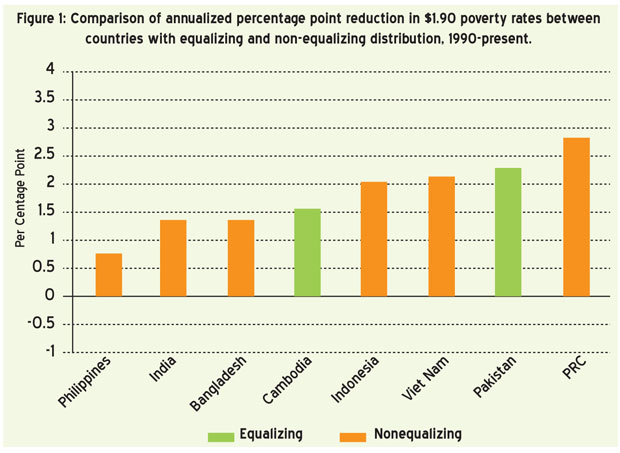Reply To:
Name - Reply Comment
Last Updated : 2024-04-26 02:12:00

 It is widely assumed that reducing inequality goes hand-in-hand with poverty reduction – but this is not always the case.
It is widely assumed that reducing inequality goes hand-in-hand with poverty reduction – but this is not always the case.
Asia and the Pacific have an impressive development scorecard: massive reduction in poverty, expanded access to clean drinking water and close to universal primary education enrolment rates. Where the region has not improved, however, is in reducing inequality. The gap between the haves and have-nots within Asian countries continues to widen.
The UN Sustainable Development Goal (SDG) No. 10 focuses on reducing inequalities within and among countries. To monitor progress toward it, we track the differences between the income growth of the bottom 40 percent of a given country’s total population and the national average. This is founded on the assumption that promoting faster income growth for the bottom 40 percent relative to the national average will allow the poor to catch up with the rest and thus bring about a more equitable distribution of economic opportunities.
But this is not necessarily the case, as we discovered by analysing data from the World Bank’s Povcalnet database for 26 of the Asian Development Bank’s (ADB) developing member countries. We found that there may be elements of a trade-off between fighting poverty and reducing inequality. Figure 1 describes the rate at which US $ 1.90 a day poverty incidence has changed for selected ADB developing member countries with available data. It also distinguishes between countries on the basis of whether the bottom 40 percent experienced income growth higher than average incomes or not. The former countries are labelled as having ‘equalizing’ distribution, while the latter have a ‘non-equalizing’ distribution.
The data show that some of the fastest reductions in poverty were registered by countries with widening inequality as defined by SDG 10. This pattern is consistent even if we use the US $ 3.10 poverty line or other measures of inequality such as the Palma ratio.
In fact, the countries with the highest average income growth—but higher levels of inequality—saw some of the largest reductions in poverty. Millions of people have been lifted out of poverty in Bangladesh, the People’s Republic of China (PRC), Indonesia and Viet Nam because these countries posted remarkable average income growth rates. For instance, the per capita income in the PRC has grown at an annual rate of 7 percent since the 1990s, while the annual growth rates for Viet Nam and Indonesia for the same period have been 6 percent and 4 percent, respectively.
Thus, it can be problematic to assume too much about a country’s development performance just because income growth is skewed to higher earners, without considering the impact of this on other SDGs such as ending poverty (SDG 1). It is also conceivable that excessive focus on SDG 10 could render countries with declining incomes across the board as ‘performers’, simply because average income growth is falling faster than growth for the bottom 40 percent.
As we have seen in the PRC, India, Indonesia and Viet Nam, ADB’s developing member countries can reduce poverty significantly as long as their average income growth is fast – even if the income of the upper 60 percent of the population grew faster than that of the bottom 40 percent. On the other hand, in countries such as the Philippines—where income growth of higher earners was not significantly faster than for lower incomes—the average income (and, accordingly, the national poverty rates) hardly budged.There is no question that inequality needs to be addressed through the SDGs. However, we should take a closer look at how we measure poverty and inequality, as well as the links and possible trade-offs between the two. And we must do this without losing sight of other important dimensions of development beyond inequality—such as increasing access to high-quality jobs, services, and infrastructure for the poor.
(Arturo Martinezis is a Statistician at Economic Research and Regional Cooperation Department at Asian Development Bank)

Add comment
Comments will be edited (grammar, spelling and slang) and authorized at the discretion of Daily Mirror online. The website also has the right not to publish selected comments.
Reply To:
Name - Reply Comment
US authorities are currently reviewing the manifest of every cargo aboard MV
On March 26, a couple arriving from Thailand was arrested with 88 live animal
According to villagers from Naula-Moragolla out of 105 families 80 can afford
Is the situation in Sri Lanka so grim that locals harbour hope that they coul